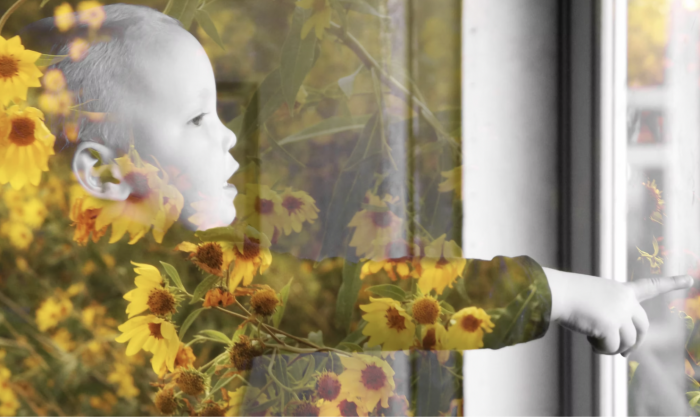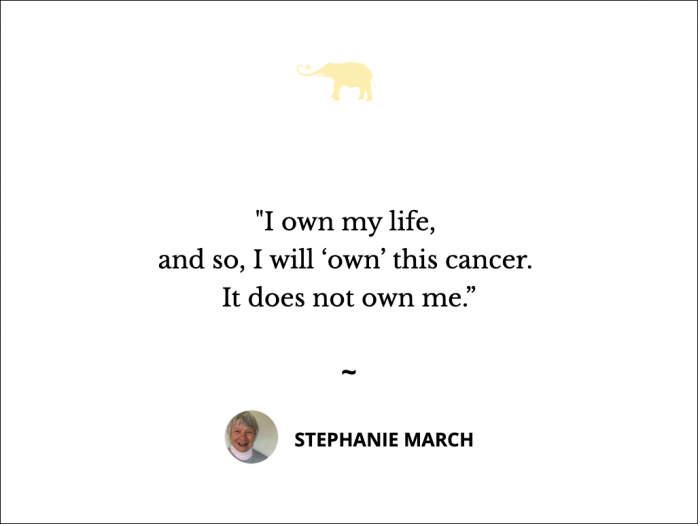“Ms. March, the surgery confirmed that you have uterine cancer!”
Wham!
It all happened within a nanosecond.
Cancer’s iron fist delivered a neck-jolting jab square to my jaw, squeezed a hand around my throat leaving me breathless, twisted my gut into a distorted knot of wrenching pain, and gripped nerves that left me momentarily paralyzed and mute.
Every dream and expectation of my future sped before me in a swirling tsunami—and in that moment, I despaired that my future had just been canceled.
Cancer had sucked the life from my body to create a life of its own. I felt as if it stood towering over me with one foot planted on my chest, pinning me to the bed, and leaving me splayed and defenseless against its ultimate power and absolute control.
It was undeniably the most terrifying moment of my life, propelling the entire day into one of non-stop cycles of disbelief, crying, cursing, and sharing the news with my closest family and friends.
How? How long? Why?
My God, why!?
So many questions to ask, so much information to learn, and not a single answer for any of it. Not on that day. The doctor said he’d see me in his office in about a week when the detailed pathology reports were back, and we would talk then.
It wasn’t as if cancer was any stranger to my life. I moved to Philly in the mid-70s to accept a nursing position at Children’s Hospital (CHOP), where I learned during orientation that I would be working on their oncology unit. It wasn’t a unit that I had included among my “preferences” on their application and so I was sure it had to be a mistake.
“No,” they said, “comments from all your interviews and the profile questionnaire you completed indicate that you’ll be a great fit with that group of patients. We never insist that anyone work there, but we’d love you to give it a try.”
I accepted the challenge and worked at CHOP for two years in what I have always known as the most rewarding job of my life. While a significant part of a nurse’s role is to educate patients and their families, the children there taught me as much as I taught them.
A most memorable realization that I took away from that experience is that children—unlike most of the adult and geriatric patients I’d cared for in previous jobs—have not yet learned “how to be sick.” I’d start an IV in their arm to infuse their chemo, and they’d ask me to hang the bag on a portable IV pole so that they could go to the playroom. I’d remind them that they had a 10:00 am CT scan, and they’d remind me that Sesame Street came on at 11.
They had their priorities in order and never failed to remind their care providers what was most important. For them, cancer was an intermittent intruder and while it undoubtedly impacted their life, it was also not their life.
The lessons from these young teachers landed solidly with me. And during my going away dinner from CHOP, my colleagues confirmed that I had passed the final exam. As was customary at these events, dessert was the time for shared thoughts about the departing staff member and what they had left as their legacy.
In the highest compliment ever paid to me, they said that I had made it okay to laugh again and had brought back the sound of laughter to the unit. They would walk down the halls and hear giggles and belly laughs coming from a room where I was with one of my patients.
The trick: I would take care of them as my patients but relate to them as the children they were. I told them goofy jokes, for example, and the goofier the better. Kids receiving chemo or radiation go through many bodily changes, and I found that pairing those medical realities with the universal humor that kids share regarding poop, farts, and other bodily functions made a perfect combo.
Why did Tigger stick his head in the toilet? He was looking for Pooh!
Knock, knock!
Who’s there?
I did up.
I did up who?
Eww! You did a poo?
And…did you hear that Pixar finally made a movie for kids with cancer? It’s called Finding Chemo.
Certainly, these patients had serious illnesses; but over the years, it had somehow become accepted practice that staff showed respect for what the patients and families were going through by maintaining a serious decorum at all times. The kids, however, had shown me that was far from what they needed.
They did not intend to let cancer own them; they owned their childhood and dealt with their cancer only as required. While in the hospital, we were the ones who dubbed them our “cancer patients,” but to everyone else, they were kids: sons, daughters, siblings, grandkids, best buddies, classmates, and teammates—and that’s what they loved to be. That’s what they deserved to be, both inside and outside the hospital walls.
It was in 1975 that I committed my patients’ lessons for living to memory. I had filed them deeply but methodically in my brain so that by 2018, and within one week of learning my diagnosis, I was easily able to retrieve and apply them, just as I had watched “my kids” do time and time again.
The guiding principle: “I own my life and so I will ‘own’ this cancer. It does not own me.”
From these kids that I cared for—and cared so deeply about—came my instruction manual for navigating my own cancer journey.
1. Don’t wait for the doctor.
The doctor had said to see him in seven days. He was clearly not the keeper of his calendar and unaware that his “earliest available” was two weeks out. That gave me time to research the hell out of my disease and treatment, so that I not only acquired volumes of new information on my own, but also had the basis for the long list of questions I needed to discuss with him.
2. Beat ‘em at their own game.
In addition to all the new information collected, an old tidbit gained from my days as a “computer nurse” proved invaluable. I knew that doctors not only have financial incentives to see as many patients as possible each day, but that their computerized schedules are programmed to promote that—with typical appointment slots being approximately 10 minutes each.
Based on the spreadsheet of questions that I’d created, I knew that a standard slot was not going to cut it. I didn’t want to be rushed or cut off, nor did I want to be responsible for his entire day’s schedule being hijacked. I called the office back and told them I needed either a triple slot, or the last appointment of a day when he’d agree to stay until all my questions were addressed. While it pushed my appointment out by a few more days, it was well worth it and also gave me time to engage a friend to accompany me as my scribe and to ensure that between us, we’d capture every word.
3. Go deep. Go wide.
During my appointment, the doctor described the protocol for my rare and aggressive form of cancer, including the types of treatment, medications used, and side effects that I could expect.
As he saw us reach the end of my spreadsheet, he asked, “So, is that everything?”
“Everything for now” I said. “My next steps are to do some further reading about what you just shared and to get some second opinions.”
4. Exercise your options.
I obtained those second opinions, continued to research my condition, and decided to stay with my original oncologist. A prediction he shared–that hair loss would most likely occur about three weeks after my first dose of chemo—suggested that going bald was inevitable, but the options available to me for how to respond to and manage that baldness were many.
Based on some tips and suggestions from my daughter, combined with flashbacks to the lessons from my CHOP kids, I knew that my decision would have to allow two things: to control what I could—and to have some fun while doing it.
5. Throw a party.
Instead of letting cancer and chemo define when and how my hair would fall out—presumably in clumps and at random intervals—I took charge and planned “Stef’s Buzz Fest.”
I booked my hairstylist to come to my home, created a playlist (Are you hearing “I’m Too Sexy for My Hair”?), and ordered custom buttons to commemorate the event. My guests included five friends who live locally and joined me at home with five more from other parts of the country and world who partied with us virtually.
While everyone watched Carl take the clippers to my scalp, I panned the faces of my friends in the room and those of my remote guests displayed on cell phone video screens. I saw no shock, no horror, no tears, but only celebratory smiles that said we were doing an awesome thing.
6. Let people know you need them.
That event marked the beginning of something new for me—a willingness to talk candidly about the challenging times I was going through and to then not only open myself to offers of support and assistance but to admit that I needed and welcomed them.
As I began to receive cards, prayers, clown noses, tiaras, jokes, playdate invitations—and even offers to wash my windows—I decided to put up a bulletin board in my dining room where I could post them and be continually reminded of the love that surrounded me. By the time my treatment was complete, my collection had grown to four large boards covered in love!
With the loving support of my family and friends, some kids with cancer from the ’70s, and some awesome healthcare professionals in Philly, I held cancer at bay for two years. It made a comeback in 2020 but did not storm its way in as it had originally done. Already once beaten, it apparently counted on slithering in unnoticed and trying to build a new stronghold.
But that’s not how it works this time, Cancer! You went down once and you’re going down again.
There’s a new boss in town who wields the control and holds the power.
Wham! I’ve got this!
~
~












Read 4 comments and reply